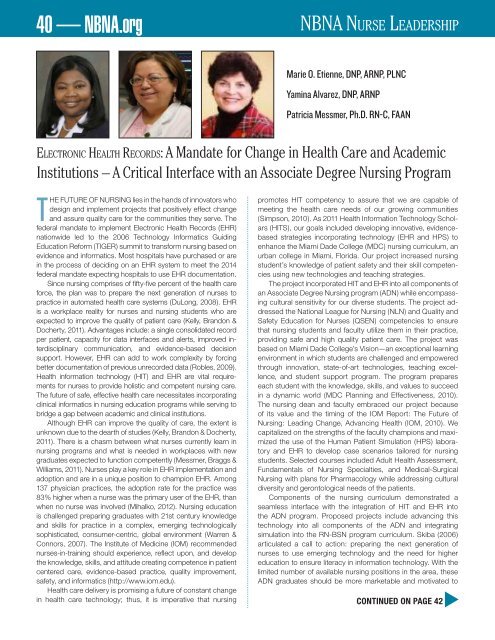NBNA SPECIAL ISSUE ON THE FUTURE OF NURSING
NBNA SPECIAL ISSUE ON THE FUTURE OF NURSING
NBNA SPECIAL ISSUE ON THE FUTURE OF NURSING
You also want an ePaper? Increase the reach of your titles
YUMPU automatically turns print PDFs into web optimized ePapers that Google loves.
40 — <strong>NBNA</strong>.org nBnA nurse LeAdershIp<br />
eLectronIc heALth records: A Mandate for Change in Health Care and Academic<br />
Institutions – A Critical Interface with an Associate Degree Nursing Program<br />
THe fUtUre of NUrsiNG lies in the hands of innovators who<br />
design and implement projects that positively effect change<br />
and assure quality care for the communities they serve. the<br />
federal mandate to implement electronic Health records (eHr)<br />
nationwide led to the 2006 technology informatics Guiding<br />
education reform (tiGer) summit to transform nursing based on<br />
evidence and informatics. most hospitals have purchased or are<br />
in the process of deciding on an eHr system to meet the 2014<br />
federal mandate expecting hospitals to use eHr documentation.<br />
since nursing comprises of fifty-five percent of the health care<br />
force, the plan was to prepare the next generation of nurses to<br />
practice in automated health care systems (Dulong, 2008). eHr<br />
is a workplace reality for nurses and nursing students who are<br />
expected to improve the quality of patient care (kelly, Brandon &<br />
Docherty, 2011). Advantages include: a single consolidated record<br />
per patient, capacity for data interfaces and alerts, improved interdisciplinary<br />
communication, and evidence-based decision<br />
support. However, eHr can add to work complexity by forcing<br />
better documentation of previous unrecorded data (robles, 2009).<br />
Health information technology (Hit) and eHr are vital requirements<br />
for nurses to provide holistic and competent nursing care.<br />
the future of safe, effective health care necessitates incorporating<br />
clinical informatics in nursing education programs while serving to<br />
bridge a gap between academic and clinical institutions.<br />
Although eHr can improve the quality of care, the extent is<br />
unknown due to the dearth of studies (kelly, Brandon & Docherty,<br />
2011). there is a chasm between what nurses currently learn in<br />
nursing programs and what is needed in workplaces with new<br />
graduates expected to function competently (messmer, Braggs &<br />
Williams, 2011). Nurses play a key role in eHr implementation and<br />
adoption and are in a unique position to champion eHr. Among<br />
137 physician practices, the adoption rate for the practice was<br />
83% higher when a nurse was the primary user of the eHr, than<br />
when no nurse was involved (mihalko, 2012). Nursing education<br />
is challenged preparing graduates with 21st century knowledge<br />
and skills for practice in a complex, emerging technologically<br />
sophisticated, consumer-centric, global environment (Warren &<br />
connors, 2007). the institute of medicine (iom) recommended<br />
nurses-in-training should experience, reflect upon, and develop<br />
the knowledge, skills, and attitude creating competence in patient<br />
centered care, evidence-based practice, quality improvement,<br />
safety, and informatics (http://www.iom.edu).<br />
Health care delivery is promising a future of constant change<br />
in health care technology; thus, it is imperative that nursing<br />
Marie O. Etienne, DNP, ARNP, PLNC<br />
Yamina Alvarez, DNP, ARNP<br />
Patricia Messmer, Ph.D. RN-C, FAAN<br />
promotes Hit competency to assure that we are capable of<br />
meeting the health care needs of our growing communities<br />
(simpson, 2010). As 2011 Health information technology scholars<br />
(Hits), our goals included developing innovative, evidencebased<br />
strategies incorporating technology (eHr and HPs) to<br />
enhance the miami Dade college (mDc) nursing curriculum, an<br />
urban college in miami, florida. our project increased nursing<br />
student’s knowledge of patient safety and their skill competencies<br />
using new technologies and teaching strategies.<br />
the project incorporated Hit and eHr into all components of<br />
an Associate Degree Nursing program (ADN) while encompassing<br />
cultural sensitivity for our diverse students. the project addressed<br />
the National league for Nursing (NlN) and Quality and<br />
safety education for Nurses (QseN) competencies to ensure<br />
that nursing students and faculty utilize them in their practice,<br />
providing safe and high quality patient care. the project was<br />
based on miami Dade college’s Vision—an exceptional learning<br />
environment in which students are challenged and empowered<br />
through innovation, state-of-art technologies, teaching excellence,<br />
and student support program. the program prepares<br />
each student with the knowledge, skills, and values to succeed<br />
in a dynamic world (mDc Planning and effectiveness, 2010).<br />
the nursing dean and faculty embraced our project because<br />
of its value and the timing of the iom report: the future of<br />
Nursing: leading change, Advancing Health (iom, 2010). We<br />
capitalized on the strengths of the faculty champions and maximized<br />
the use of the Human Patient simulation (HPs) laboratory<br />
and eHr to develop case scenarios tailored for nursing<br />
students. selected courses included Adult Health Assessment,<br />
fundamentals of Nursing specialties, and medical-surgical<br />
Nursing with plans for Pharmacology while addressing cultural<br />
diversity and gerontological needs of the patients.<br />
components of the nursing curriculum demonstrated a<br />
seamless interface with the integration of Hit and eHr into<br />
the ADN program. Proposed projects include advancing this<br />
technology into all components of the ADN and integrating<br />
simulation into the rN-BsN program curriculum. skiba (2006)<br />
articulated a call to action: preparing the next generation of<br />
nurses to use emerging technology and the need for higher<br />
education to ensure literacy in information technology. With the<br />
limited number of available nursing positions in the area, these<br />
ADN graduates should be more marketable and motivated to<br />
coNtiNUeD oN PAGe 42


